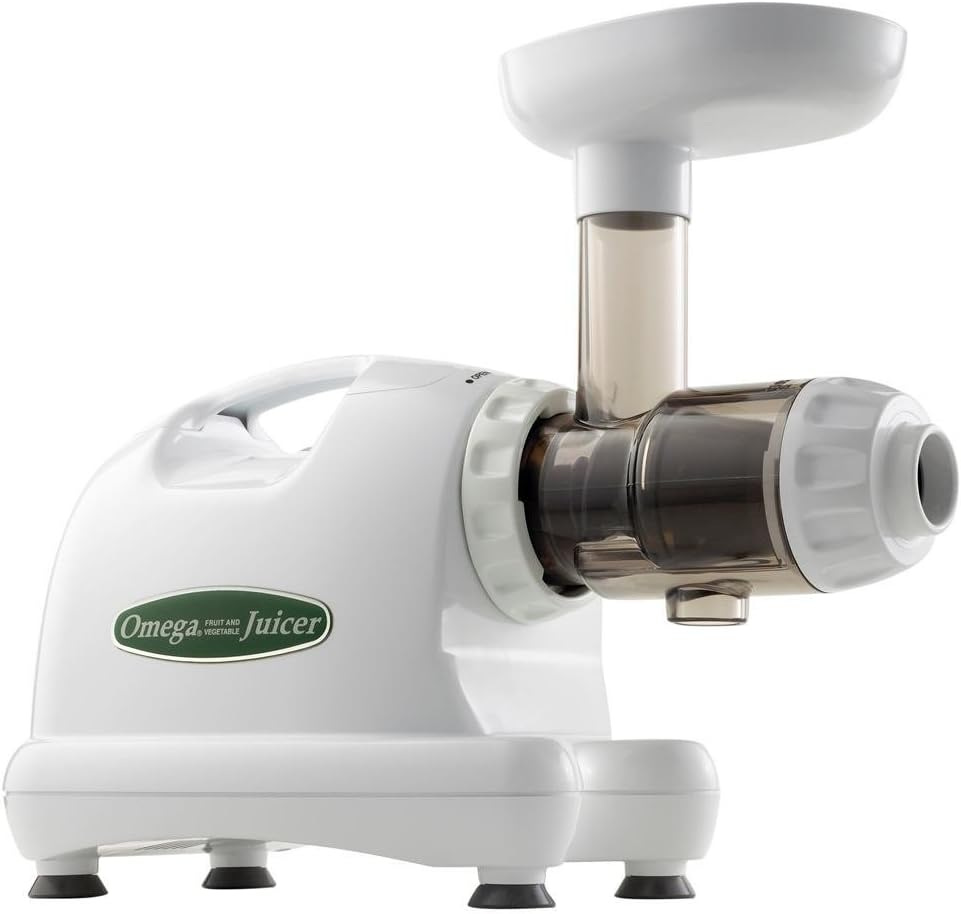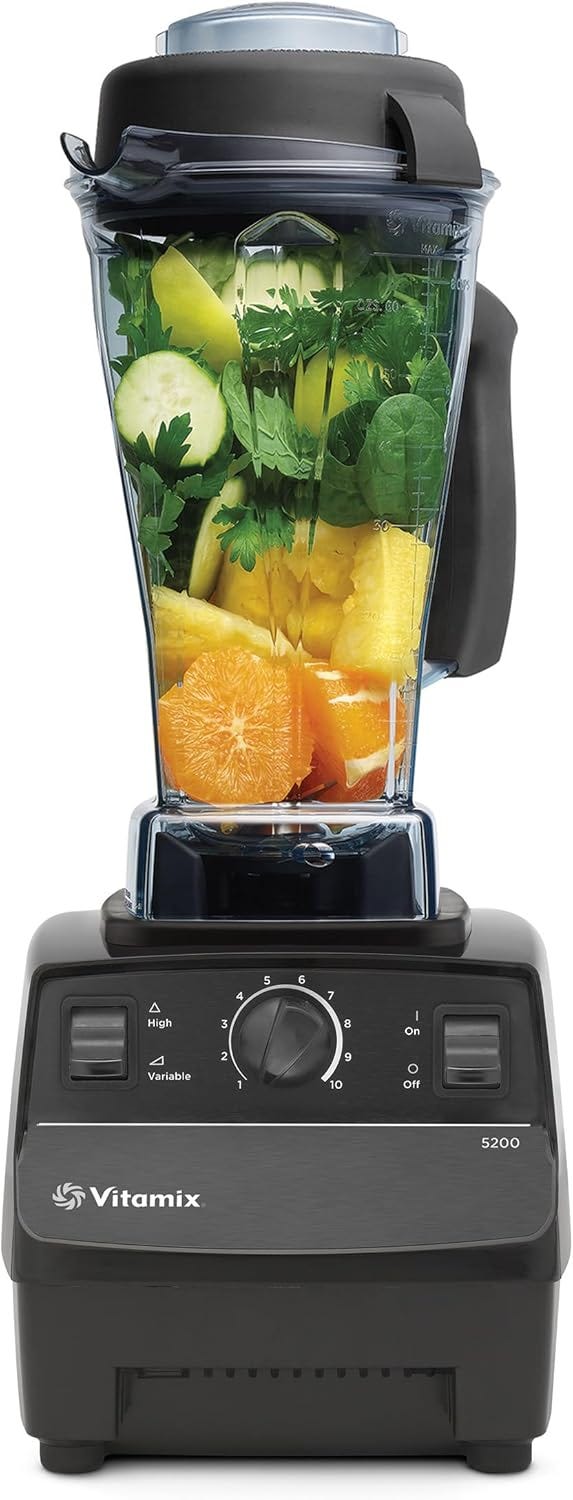Juice Extractors
Tools for Possibilities: issue no. 110
Quiet, versatile juice extractor
I eat fruits and veggies, but based on everything I’ve read, the potential health benefits of juicing are too great to pass up. Unless you’re an impatient person, the Omega 8003 is great for a beginning juicer. It not only handles apples, oranges and carrots, but won’t get bogged down with wheatgrass, spinach and other leafy greens. Unlike a centrifugal juicer, which violently shreds what you put in it, the Omega 8003 uses what is known as a dual-screen, single auger. That means it doesn’t cut or chew as much as it mashes pulp forward into the end of a cone using the pressure of a spinning auger. The juice yield definitely trumps my old Braun centrifugal juicer, which can’t handle wheatgrass. The pulp I get from the Omega is drier and if need be, I can easily put it back through for a tiny bit more juice. I put the pulp from the Braun into the Omega and actually got several extra tablespoons of juice!
Of all the machines I’ve researched, tested and used, the Omega 8003 just crushes every piece of machinery, especially at this price. After eight months, I still use the juicer almost every other day and nothing has broken or malfunctioned. Juice extractors tend to be jet-engine loud. While the Omega’s motor is strong and hums with authority, it’s killer quiet. I can easily juice in the early morning or night without waking my wife or the neighbors. It’s also not too large in size and the folding handle on top makes moving the machine around much easier than other machines. The construction is solid. Omega backs it up with 10-year warranty. — Jim Rubel
Before purchasing a juicer I extensively researched what was available and ultimately purchased the Omega Juicer 8004.
I have been using the Omega juicer twice daily for the past few months. There are two major types of juicers, centrifugal and masticating. The Omega 8004 is the latter. Centrifugal juicers have higher juice yields for some kinds of fruits and vegetables and are a bit faster than masticating juicers, but masticating juicers are better for a litany of reasons.
First, they’re quiet. The Omega juicer operates at about 80RPM at a tolerable decibel level. Centrifugal juicer are LOUD. They also work better with leafy greens like kale, swiss chard, spinach, etc. They also can be used for a variety of tasks. Masticating juicers are multifunctional in that they can be put to use making pasta, nut butters and milks, and baby food.
One of the biggest reasons the Omega 8004 is superior is because it is easy to clean. It disassembles quickly and the parts can be cleaned in just a minute or two. The construction is also quite solid. The Omega 8004 and its slightly more expensive counterpart the Omega 8006 are the only juicers on the market that have a 15 year warranty. And the only difference between the 8004 and the 8006 is the finish: the 8004 is white plastic and the 8006 has a black and chrome finish.
On the downside it is ugly, but in my opinion all juicers are ugly and in this case it is a question of function over form. It also has a large footprint compared to other juicers, and this is an issue for people who have small kitchens. I live in New York, but am fortunate enough to have a decent sized kitchen.
One other small issue is the size of the feed tube, which is rather narrow (about an inch and a half in diameter), which makes it necessary to cut up fruits and vegetables a bit more than some other juicers on the market.
Omega has another line of masticating juicer which are “vertical” taking up less counter space, have larger feed tubes, and are highly recommended by people who seem to know what they are talking about on the Internet. However, they are a lot more expensive.
I chose the 8004 over the Omega vertical models, because the 8004/8006 seemed mechanically simpler and has a 15 year vs. 10 year warranty. Overall, I have found the Omega 8004 easy to use and actually fun. The variety of juice you can make is amazing. I will let others discuss the health benefits of juicing, but unscientifically after using it I have lost some weight and feel really great. — Max Abramowitz
The ultimate blender
VitaMix 5200 Countertop Blender
I once believed that a blender only needed two speeds: Off and High. I was wrong. With ten variable speeds, it makes short work of anything and everything we’ve ever put in it. We use it every single day, often multiple times. The 1380-watt motor surprisingly quiet on low, and a barracuda at high speeds. Clean-up is incredibly quick: Add water, a bit of soap, turn on high for ten seconds, and then rinse and dry.
The 64-ounce Lexan pitcher is amazingly tough. I always figured plastic was plastic, but this stuff is really tough. If you do happen to somehow break it, the company will replace it free of charge through its seven-year warranty. After that, you can simply purchase parts/replacements.
So we extended our 30-day trial to 90-days, since I still thought it was a lot of money for a blender. Ultimately — after using it EVERY day, usually multiple times a day — I realized it’s worth $350. I hesitated to send this review, because of the considerable expense. Anyone who uses a blender regularly will find this to be the best blender they ever own. My previous $45 blender, which I once thought was pretty good, now sits gathering dust. I’ve been spoiled. — Jeff Jewell
Hand-powered juicer
Living in Southern California, we have an abundance of citrus nearly year round — lemons, limes, kumquats, grapefruits, and more. I also have a household of beverage enthusiasts, from my kids who love to make lemon-, lime-, etc. -ades, or “kid drinks” as they call them, to my wife and I who are crazy about cocktails, flips, fizzes, and sours. This is why I graduated from my fine, but slow, hand juicer, to the monstrous, restaurant-calibre Ra Chand J210 Bar Juicer. It makes quick, efficient work of juicing tons of citrus. Rather than dread all the labor, I’m now happy to juice enough fruit to make a full pitcher of Ginger Limeonade with my kids to sell in their DIY juice stand.
The Ra Chand is dead simple. No motors or fragile plastic parts to break — in fact it only has six parts, made of cast aluminum, plus a wire return spring and a few bolts. The mechanical advantage it provides is tremendous. With its long lever and offset pivots, even my six-year-old daughter can use it to easily squeeze a half-lemon dry. The Ra Chand is big enough for me to juice a medium grapefruit — when I have a larger-sized one to contend with I quarter it (and secretly wish I had the even-larger model, the J500).
The straining cone (which looks like a half beehive) allows juice and the occasional small seed through, but very little pulp. This is also due to the fact that pressing (rather than twisting like a motorized juicer) bursts the cells of the fruit, but doesn’t shred the membranes.
If I have one complaint it is that the juicer can be tipped forward easily until you get the hang of pulling the lever down, not down-and-toward-yourself. I’ve gotten used to this, but I do hold onto the base when my kids use it to avoid a mess.
In all, the Ra Chand is hands-down the best citrus juicer I’ve used. I appreciate its size, speed, power, ruggedness, and simplicity. I imagine it’ll be in our family for many years, hopefully providing juice for generations. — John Edgar Park



